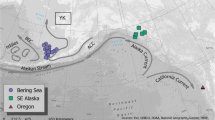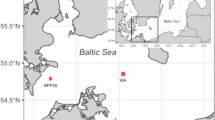Abstract
Gastropods retain less obvious periodic growth marks on calcified structures than individuals in other groups (e.g. bivalves, cephalopods, fish), a fact that has hampered age estimation in this Class. Nevertheless, a model of age estimation for the gastropod Nassarius reticulatus is possible based on the annual growth rings deposited in statoliths during the winter. These spherical aragonitic carbonate structures are located inside the statocysts and contain a characteristic microstructural pattern of concentric rings. However, this pattern can be biased by the formation of nonperiodic disturbance rings (DRs). In Aveiro (NW Portugal), an increased frequency of DRs was reported in statoliths of specimens inhabiting the Ria de Aveiro lagoon (a highly dynamic environment), when compared with specimens collected from the relatively environmentally stable adjacent offshore area. One approach to resolve annual growth in organically precipitated carbonates is to find a chemical signature within the microstructure that faithfully records changes in seasonal environmental parameters. In this contribution, we have analysed the Sr Ca−1 variation along statolith sections by laser ablation inductively coupled plasma mass spectrometry (LA-ICPMS) as a proxy to resolve seasonal cycles of temperature, allowing the identification of annual growth rings. Combining this information with size–frequency distributions of shell height, we found strong evidence that the rings chemically labelled with 88Sr 48Ca−1 peaks are formed annually during the cold season. Hence, LA-ICPMS allows not only the detection of visible rings but also the distinction between rings formed at low temperatures (i.e. a periodic seasonal signature) and those of disturbance (not characterised by increased 88Sr 48Ca−1). There is also clear evidence that the 88Sr 48Ca−1 peaks become less conspicuous from the nucleus to the statolith edge, leading to a loss of discriminatory power for the identification of older age rings. Nevertheless, this new method allows the accurate age estimation of N. reticulatus specimens and is liable to be applied in a wide range of gastropods after specific validation.




Similar content being viewed by others
References
Arkhipkin AI, Campana SE, FitzGerald J, Thorrold SR (2004) Spatial and temporal variation in elemental signatures of statoliths from the Patagonian longfin squid (Loligo gahi). Can J Fish Aquat Sci 61:1212–1224. doi:10.1139/f04-075
Arrighetti F, Teso V, Brey T et al (2012) Age and growth of Olivancillaria deshayesiana (Gastropoda: Olividae) in the Southwestern Atlantic Ocean. Malacologia 55:163–170. doi:10.4002/040.055.0111
Barroso CM, Moreira MH (1998) Reproductive cycle of Nassarius reticulatus in the Ria de Aveiro, Portugal: implications for imposex studies. J Mar Biol Assoc UK 78:1233–1246. doi:10.1017/S0025315400044453
Barroso CM, Moreira MH, Richardson CA (2005a) Age and growth of Nassarius reticulatus in the Ria de Aveiro, north-west Portugal. J Mar Biol Assoc UK 85:151–156. doi:10.1017/S0025315405010970h
Barroso CM, Nunes M, Richardson CA, Moreira MH (2005b) The gastropod statolith: a tool for determining the age of Nassarius reticulatus. Mar Biol 146:1139–1144. doi:10.1007/s00227-004-1516-2
Barroso CM, Rato M, Veríssimo A et al (2011) Combined use of Nassarius reticulatus imposex and statolith age determination for tracking temporal evolution of TBT pollution in the NW Portuguese continental shelf. J Environ Monitor 13:3018–3025. doi:10.1039/c1em10508f
Bell JL (1984) Statoliths as age indicators in gastropod larvae—application to measurement of field growth-rates. Pac Sci 38:357
Bretos M (1980) Age determination in the keyhole limpet Fissurella crassa Lamarck (Archaeogastropoda: Fissurellidae), based on shell growth rings. Biol Bull 159:606–612
Carré M, Bentaleb I, Bruguier O et al (2006) Calcification rate influence on trace element concentrations in aragonitic bivalve shells: evidences and mechanisms. Geochim Cosmochim Acta 70:4906–4920. doi:10.1016/j.gca.2006.07.019
Chase R (2002) Behavior and its neural control in Gastropod Molluscs. Oxford University Press, New York
Chatzinikolaou E, Richardson C (2007) Evaluating growth and age of netted whelk Nassarius reticulatus (Gastropoda: Nassariidae) using statolith growth rings. Mar Ecol Prog Ser 342:163–176. doi:10.3354/meps342163
Chatzinikolaou E, Richardson CA (2008) Population dynamics and growth of Nassarius reticulatus (Gastropoda: Nassariidae) in Rhosneigr (Anglesey, UK). Mar Biol 153:605–619. doi:10.1007/s00227-007-0835-5
De Villiers S, Nelson BK, Chivas AR (1995) Biological controls on coral Sr/Ca and dgr18O reconstructions of sea surface temperatures. Science 269:1247–1249. doi:10.1126/science.269.5228.1247
Dias JM, Lopes J, Dekeyser I (1999) Hydrological characterisation of Ria de Aveiro, Portugal, in early summer. Oceanol Acta 22:473–485
Du J (2002) Combined algorithms for constrained estimation of finite mixtures distribution with grouped data and conditional data. In: Master thesis, McMaster University, Ontario, Canada
Fretter V, Graham A (1962) British Prosobranch Molluscs: their functional anatomy and ecology. The Ray Society, Adlard & Son Ltd, Bartholomew Press, Dorking
Galante-Oliveira S, Marçal R, Ribas F et al (2013) Studies on the morphology and growth of statoliths in Caenogastropoda. J Mollus Stud 79:340–345. doi:10.1093/mollus/eyt028
Galante-Oliveira S, Marçal R, Guimarães F et al (2014) Crystallinity and microchemistry of Nassarius reticulatus (Caenogastropoda) statoliths: towards their structure stability and homogeneity. J Struct Biol 186:292–301. doi:10.1016/j.jsb.2014.03.023
Gillikin DP, Lorrain A, Navez J et al (2005) Strong biological controls on Sr/Ca ratios in aragonitic marine bivalve shells. Geochem Geophys Geosyst 6:Q05009. doi:10.1029/2004GC000874
Grana-Raffucci FA, Appeldoorn RS (1997) Age determination of larval strombid gastropods by means of growth increment counts in statoliths. Fish Bull 95:857–862
Leiva GE, Castilla JC (2002) A review of the world marine gastropod fishery: evolution of catches, management and the Chilean experience. Rev Fish Biol Fish 11:283–300. doi:10.1023/A:1021368216294
Lloyd DC, Zacherl DC, Walker S et al (2008) Egg source, temperature and culture seawater affect elemental signatures in Kelletia kelletii larval statoliths. Mar Ecol Prog Ser 353:115–130. doi:10.3354/meps07172
MacDonald P (2002) MIX software for mixture distributions. R Foundation for statistical computing, Institute for Statistics and Mathematics, University of Vienna, Austria. http://www.math.mcmaster.ca/peter/mix/mix.html. Accessed 13 Nov 2014
Manríquez P, Galaz S, Opitz T et al (2012) Geographic variation in trace-element signatures in the statoliths of near-hatch larvae and recruits of Concholepas concholepas (loco). Mar Ecol Prog Ser 448:105–118. doi:10.3354/meps09514
Marohn L, Hilge V, Zumholz K et al (2011) Temperature dependency of element incorporation into European eel (Anguilla anguilla) otoliths. Anal Bioanal Chem 399:2175–2184. doi:10.1007/s00216-010-4412-2
Miranda RM, Fujinaga K, Nakao S (2008) Age and growth of Neptunea arthritica estimated from growth marks in the operculum. Mar Biol Res 4:224–235. doi:10.1080/17451000701881706
Moore HB (1938) The biology of Purpura lapillus. III. Life history and relation to environmental factors. J Mar Biol Assoc UK 23:67–74
Mueller KW, Stoner AW (2013) Proxy measures for Queen Conch (Strombus gigas linné, 1758) age and maturity: relationships between shell lip thickness and operculum dimensions. J Shellfish Res 32:739–744. doi:10.2983/035.032.0316
Ono K, Licandeo R, Muradian ML et al (2014) The importance of length and age composition data in statistical age-structured models for marine species. ICES J Mar Sci. doi:10.1093/icesjms/fsu007
Purton LMA, Shields GA, Brasier MD, Grime GW (1999) Metabolism controls Sr/Ca ratios in fossil aragonitic mollusks. Geology 27:1083–1086. doi:10.1130/0091-7613(1999)027<1083:MCSCRI>2.3.CO;2
R Development Core Team (2005) R: a language and environment for statistical computing. R Foundation for Statistical Computing, Institute for Statistics and Mathematics, University of Vienna, Austria. http://www.r-project.org. Accessed 13 Nov 2014
Richardson CA (2001) Molluscs as archives of environmental change. Oceanogr Mar Biol 39:103–164
Richardson CA, Kingsley-Smith PR, Seed R, Chatzinikolaou E (2005a) Age and growth of the naticid gastropod Polinices pulchellus (Gastropoda: Naticidae) based on length frequency analysis and statolith growth rings. Mar Biol 148:319–326. doi:10.1007/s00227-005-0072-8
Richardson CA, Saurel C, Barroso CM, Thain J (2005b) Evaluation of the age of the red whelk Neptunea antiqua using statoliths, opercula and element ratios in the shell. J Exp Mar Biol Ecol 325:55–64. doi:10.1016/j.jembe.2005.04.024
Selin NI, Dolganova AS (2003) Distribution patterns and size–age composition in aggregations of the Gastropod Mollusk Nucella heyseana in Peter the Great Bay, Sea of Japan. Russ J Mar Biol 29:348–357. doi:10.1023/B:RUMB.0000011701.18028.d0
Sosdian S, Gentry DK, Lear CH et al (2006) Strontium to calcium ratios in the marine gastropod Conus ermineus: growth rate effects and temperature calibration. Geochem Geophys Geosyst 7:Q11023. doi:10.1029/2005GC001233
Tétreault F, Himmelman JH, Measures L (2000) Impact of a castrating trematode, Neophasis sp., on the common whelk, Buccinum undatum, in the northern Gulf of St. Lawrence. Biol Bull 198:261–271
Vasconcelos P, Gaspar MB, Pereira AM, Castro M (2006) Growth rate estimation of Hexaplex (trunculariopsis) trunculus (Gastropoda: Muricidae) based on mark/recapture experiments in the Ria Formosa lagoon (Algarve coast, southern Portugal). J Shellfish Res 25:249–256. doi:10.2983/0730-8000(2006)25[249:GREOHT]2.0.CO;2
Vasconcelos P, Carvalho S, Castro M, Gaspar MB (2008) The artisanal fishery for muricid gastropods (banded murex and purple dye murex) in the Ria Formosa lagoon (Algarve coast, southern Portugal). Sci Mar 72:287–298. doi:10.3989/scimar.2008.72n2287
Vasconcelos P, Gharsallah IH, Moura P et al (2012) Appraisal of the usefulness of operculum growth marks for ageing Hexaplex trunculus (Gastropoda: Muricidae): comparison between surface striae and adventitious layers. Mar Biol Res 8:141–153. doi:10.1080/17451000.2011.616896
Vaz N, Dias JM, Leitão P, Martins I (2005) Horizontal patterns of water temperature and salinity in an estuarine tidal channel: Ria de Aveiro. Ocean Dyn 55:416–429. doi:10.1007/s10236-005-0015-4
Warner RR, Swearer SE, Caselle JE et al (2005) Natal trace-elemental signatures in the otoliths of an open-coast fish. Limnol Oceanogr 50:1529–1542. doi:10.4319/lo.2005.50.5.1529
Zacherl DC, Manríquez PH, Paradis G et al (2003a) Trace elemental fingerprinting of gastropod statoliths to study larval dispersal trajectories. Mar Ecol Prog Ser 248:297–303. doi:10.3354/meps248297
Zacherl DC, Paradis G, Lea DW (2003b) Barium and strontium uptake into larval protoconchs and statoliths of the marine neogastropod Kelletia kelletii. Geochim Cosmochim Acta 67:4091–4099. doi:10.1016/s0016-7037(03)00384-3
Zumholz K, Hansteen TH, Piatkowski U, Croot PL (2007) Influence of temperature and salinity on the trace element incorporation into statoliths of the common cuttlefish (Sepia officinalis). Mar Biol 151:1321–1330. doi:10.1007/s00227-006-0564-1
Acknowledgments
This work was supported by European Funds—through FP7 research infrastructure initiative ASSEMBLE (Grant Agreement No. 227799) and the Operational Competitiveness Programme COMPETE—and by National Funds—through the Portuguese Foundation for Science and Technology projects PEst-C/MAR/LA0017/2013, UID/AMB/50017/2013, and the grant SFRH/BPD/70368/2010 (supported by funding from the Human Potential Operational Programme POPH, inscribed in the National Strategic Reference Framework and partially subsidised by the European Social Fund). The authors thank the Scottish Association of Marine Science for hosting project BIOREC under ASSEMBLE EU FP7-RI, and the colleagues Filipe Laranjeiro, Inês Louro, Inês Silva, Pedro Aires, Ruy Santos—for their assistance during sampling and specimens measuring for the SH-frequency distribution study—and Fábio Matos for his assistance with the R programming language.
Author information
Authors and Affiliations
Corresponding author
Additional information
Communicated by A. Checa.
Reviewed by A. Arkhipkin and Z. Doubleday.
Electronic supplementary material
Below is the link to the electronic supplementary material.
Rights and permissions
About this article
Cite this article
Galante-Oliveira, S., Marçal, R., Espadilha, F. et al. Detection of periodic Sr Ca−1 cycles along gastropod statoliths allows the accurate estimation of age. Mar Biol 162, 1473–1483 (2015). https://doi.org/10.1007/s00227-015-2684-y
Received:
Accepted:
Published:
Issue Date:
DOI: https://doi.org/10.1007/s00227-015-2684-y




